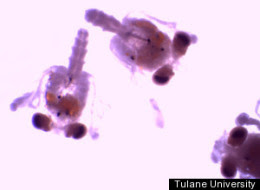 |
| Contaminated Crab Larvae |
Dan Froomkin
Huffington Post
Scientists have found signs of an oil-and-dispersant mix under the shells of tiny blue crab larvae in the Gulf of Mexico, the first clear indication that the unprecedented use of dispersants in the BP oil spill has broken up the oil into toxic droplets so tiny that they can easily enter the foodchain.
Marine biologists started finding orange blobs under the translucent shells of crab larvae in May, and have continued to find them “in almost all” of the larvae they collect, all the way from Grand Isle, Louisiana, to Pensacola, Fla. — more than 300 miles of coastline — said Harriet Perry, a biologist with the University of Southern Mississippi’s Gulf Coast Research Laboratory.
And now, a team of researchers from Tulane University using infrared spectrometry to determine the chemical makeup of the blobs has detected the signature for Corexit, the dispersant BP used so widely in the Deepwater Horizon
“It does appear that there is a Corexit sort of fingerprint in the blob samples that we ran,” Erin Gray, a Tulane biologist, told the Huffington Post Thursday. Two independent tests are being run to confirm those findings, “so don’t say that we’re 100 percent sure yet,” Gray said

Be the first to comment on "Scientists Find Evidence That Oil and Dispersant Mix is in Food Chain"